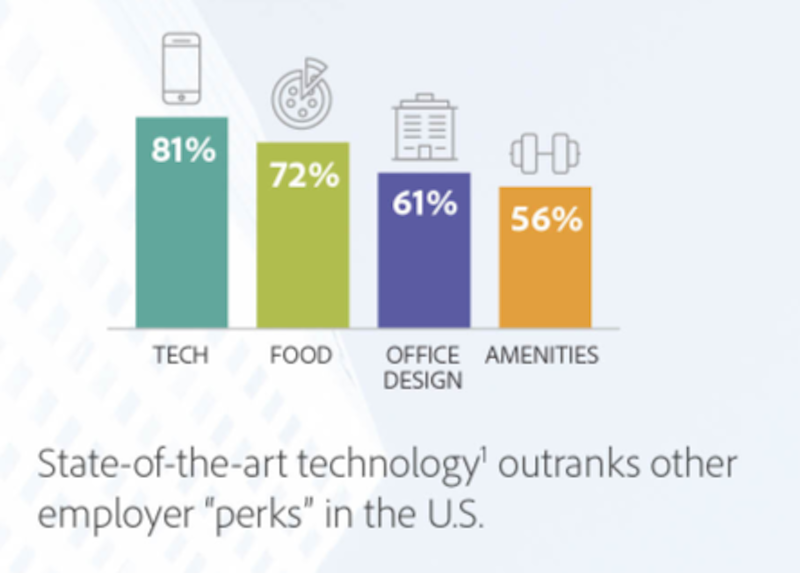American office workers love their jobs, and love them even more when the technology their companies use is viewed as being ahead of the curve.
A recent online survey of more than 1,000 office workers in the U.S., which Adobe conducted during two weeks last month, finds 70% saying they love what they do. And a remarkable 81% say that state-of-the-art technology was more important to them than an office’s design or on-site amenities.
Seven out of 10 U.S. workers believe technology improves the work-life balance, and 81% say technology helps them connect with colleagues more efficiently. Those respondents who think their company’s technology is “ahead of the curve” feel about twice as creative, motivated, and satisfied as respondents who work for companies with less-than-cutting edge technology.
The rub is that only 25% of the survey’s U.S. respondents think their company’s technology excels. Nevertheless, more than half (53%) expects technology to be handling more of their offices’ menial tasks—copying, filing, etc.—over the next two decades, even as 55% remain convinced their jobs could never be replaced by a machine.
In fact, there seems to be more than a hint of ambivalence about the benefits of technology among the 75% of respondents who are concerned that relationships and health suffer when people become to attached to their devices.

Technology trumps other office amenities in what keeps workers content. Image: Adobe's “Work in Progress” report.
The Adobe survey portrays an American workforce for which work and life are inseparable, almost to the point of obsession. More than half of the respondents say they’d keep working if they won the lottery. U.S. workers say they spend, on average, 78% of their waking hours during the work week and 41% of their days off thinking about their jobs. Indeed, 57% of respondents agree with the statement “work defines who I am.”
The desire to work is further punctuated by the finding that one in three U.S. office workers moonlights in jobs outside of his or her primary occupation, and that moonlighters are more likely to be happier and more optimistic than non-moonlighters.
However, 69% of U.S. workers also say they work multiple jobs because they need the money. Nearly three-fifths of American workers are likely to leave their jobs for a better opportunity. (That number is 50% even among people who say they profess love for their current job.)
Related Stories
| Jun 14, 2013
Purdue, industry partners test light steel framing for seismic safety
A partnership of leading earthquake engineering researchers from top U.S. and Canadian universities and design professionals from the steel industry have begun the final phase of a three-year project to increase the seismic safety of buildings that use lightweight cold-formed steel for their primary beams and columns.
| Jun 11, 2013
Finnish elevator technology could facilitate supertall building design
KONE Corporation has announced a new elevator technology that could make it possible for supertall buildings to reach new heights by eliminating several problems of existing elevator technology. The firm's new UltraRope hoisting system uses a rope with a carbon-fiber core and high-friction coating, rather than conventional steel rope.
| Jun 4, 2013
SOM research project examines viability of timber-framed skyscraper
In a report released today, Skidmore, Owings & Merrill discussed the results of the Timber Tower Research Project: an examination of whether a viable 400-ft, 42-story building could be created with timber framing. The structural type could reduce the carbon footprint of tall buildings by up to 75%.
| May 30, 2013
5 tips for running a successful BIM coordination meeting
BIM modeling tools are great, but if you can't run efficient, productive coordination meetings, the Building Team will never realize the benefits of true BIM coordination. Here are some helpful tips for making the most of coordination meetings.
| May 28, 2013
LED lighting's risks and rewards
LED lighting technology provides unique advantages, but it’s also important to understand its limitations for optimized application.
| May 20, 2013
4 emerging trends in parking structure design
Survey of parking professionals reveals how technology is transforming the parking industry.
| May 17, 2013
5 things AEC pros need to know about low-e glass
Low-emissivity glasses are critical to making today’s buildings brighter, more energy-efficient, and more sustainable. Here are five tips to help AEC professionals understand the differences among low-e glasses and their impact on building performance.
| May 17, 2013
University labs double as K-12 learning environments
Increasingly, college and university research buildings are doing double duty as homes for K-12 STEM programs. Here’s how to create facilities that captivate budding scientists while keeping faculty happy.
| May 14, 2013
Advanced turbines generate 6X more energy than conventional models
US-based wind energy company SheerWind just unveiled the INVELOX – a tunnel-based wind turbine that can produce up to 600% more power than traditional wind turbines.
| May 8, 2013
Preventable curtain wall failures - AIA/CES course
In many cases, curtain wall failures are caused by fairly simple errors that occur during the fabrication and installation process. This presentation will highlight common errors and when they typically occur.

















